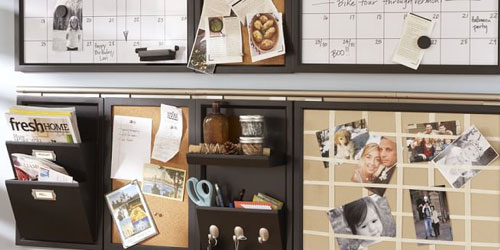How to
Organize Your Home,
Room by Room

Organization can be essential to feeling comfortable and settled in your house but, if you aren’t a naturally meticulous person, getting started on the organization journey can feel daunting. Luckily, you're not alone and we're here to help you make the process pain-free by breaking it down into a room-by-room project, instead of trying to tackle a mountain of organization all at once. From making use of wall space with hooks to selecting organizational furniture pieces for each room, there are lots of things you can do to get started. However, each room does tend to have unique needs and decor arrangements, so you may want to vary your approach as you move through the spaces in your home.
It makes sense to start with the smallest rooms in the house and work your way up. After tackling one of the smaller spaces, your confidence level will probably rise, and you’ll also have some experience you can apply to the larger rooms. The laundry room is a great place to start. Organizing this area will help you create a warm and welcoming space you'll love spending time in - and hopefully doing laundry in too!
Start by gathering all your cleaning products together by type and make sure they're clearly labeled. Next, clear out any items that should be living elsewhere. Once you've cleared the space of any excess items, invest in some clothes-sorting and laundry-storing items, such a sturdy new hamper, wall hooks for air drying delicates, and clothing racks and baskets for everything else. Oh, and don't forget to make sure the room is well lit! If it's a little dark, feel free to add an extra decorative sconce or pendant light.
The laundry room provides a natural segue to the bathroom. If you’re tired of seeing laundry piled up on the floor in the bathroom, invest in a sturdy hamper with different sections for darks, whites and colors - this will make laundry just a little bit easier every time. Then move on to the parts of the bathroom that are closer to eye level. Maybe your sink has a magic ability to accumulate clutter. Ta-dah! A cabinet or wall shelf will help keep things neatly out of sight. Leave only your most frequently used and visually appealing products out on the bathroom counter and keep everything else safely stored away in the cabinet. Don’t forget to make use of the vertical space in the bathroom; for example, if there’s an open area above the toilet, you can install a shelf for more organizational space.
Next, move onto the bedroom closet - don't worry, we're here to help! Break it down into smaller organization areas and assess your needs. (Oh, and don't be afraid to do a quick donation session to clear out extra space.) From shoe racks and small jewelry holders to complete modular closet organization systems, find the right cobination that works to keep your wardrobe in its right place. If at any point you start to feel overwhelmed, take a minute to put everything into perspective and remember that you don't have to do it all in one day. Just focus on clearing out and organizing one area at a time and congratulate yourself for every stepping stone of progress.
Next up: the entryway. With a little planning, your home’s entryway can transform from an island of clutter to an organization station where you and your family members keep outerwear such as jackets, winter boots, hats and scarves neatly organized. Other accessories, including purses and backpacks, can find a place in an entryway organization system. This is a good idea if you have small closets or find that the closet space you do have feels too cramped. Just a row of hooks and a shoe rack by the front door can make a big difference.
In rooms where you’d rather not bring in large pieces of storage furniture, such as a bedroom or living room, you can still keep things well contained. Make good use of storage spaces in other rooms, and don’t forget open drawer space in the furniture you already have. Also, start embracing the idea of repurposing furniture that’s traditionally used elsewhere. For example, a long, low dresser can make a great TV stand in a living room, and you can use the drawers to store blankets, books, board games and toys. You can also store decorative baskets or boxes in unused corners to give yourself a bit more room to keep your things uncluttered.


